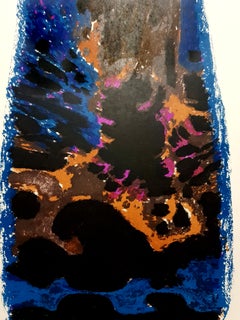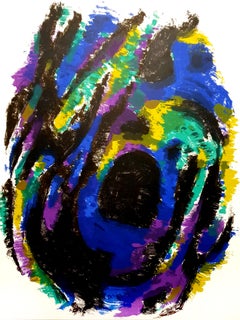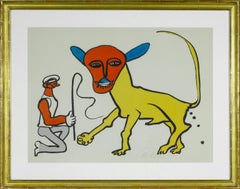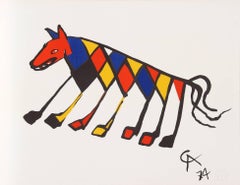Alfred MANESSIER Animal Prints
French, 1911-1993
Alfred Manessier was born on 5 December 1911 in Saint-Ouen in the Somme. Trained at the Ecole des Beaux-Arts in Amiens (1924 - 1929), he completed his training at the Ecole des Beaux-Arts in Paris and spent a brief period in the studio of the painter Roger Bissière, who introduced him to frescoes and to whom he took refuge in Boissiérettes in the Lot at the beginning of the war.
From 1947 onwards, stained glass occupied a large part of his work, which was now based on abstraction. He carried out about twenty projects in France, including the stained glass windows for the church of Saint-Michel des Bréseux (Doubs), his first commission (1948 - 1950), those in the church of Saint-Pierre de Trinquetaille in Arles (1953), and the chapel of Sainte-Thérèse de l'Enfant Jésus et de la Sainte Face in Hem (Nord - 1957). The stained glass windows of the Church of the Holy Sepulchre in Abbeville, one of his last commissions carried out between 1982 and 1993, are considered his masterpiece. He also executed a dozen stained glass projects in Switzerland, Germany and Spain.
As an abstract painter of the Ecole de Paris, Manessier frequently tackled subjects related to the Catholic religion. His paintings are often inspired by the landscapes of Northern France, but also by his travels. From 1956 onwards, he produced a large number of political paintings entitled "Hommage", which echoed the violence in the world.
The dissemination of his artworks in the public space through these stained glass windows gave him great notoriety during his lifetime, and his paintings were awarded numerous international prizes (such as the Grand Prix of the Venice Biennale, which he received in 1962, alongside Albert Giacometti, who received the Grand Prix for sculpture).
He died on 1er August 1993 as a result of a car accident, shortly after the completion of the stained glass windows in Abbeville.to
2
Overall Width
to
Overall Height
to
2
28
194
161
118
99
2
2
2
2
2
2
1
1
1
1
2
2
Artist: Alfred MANESSIER
Alfred Manessier - Lithograph
By Alfred Manessier
Located in Collonge Bellerive, Geneve, CH
Alfred Manessier - Lithograph
1962
From the art periodical XXe Siecle (no. 20)
Dimensions: 32 x 24
Edition: G. di San Lazzaro.
Unsigned and unnumbered as issued
Category
1960s Modern Alfred MANESSIER Animal Prints
Materials
Lithograph
Alfred Manessier - Original Lithograph
By Alfred Manessier
Located in Collonge Bellerive, Geneve, CH
Alfred Manessier - Original Lithograph
Colorful Abstraction
1962
From XXe Siecle
Dimensions: 32 x 24
Edition: G. di San Lazzaro.
Unsigned and unumbered as issued
Category
1960s Modern Alfred MANESSIER Animal Prints
Materials
Lithograph
Related Items
"Lion Tamer" framed signed lithograph by Alexander Calder. Edition EA of 100.
By Alexander Calder
Located in Boca Raton, FL
"Lion Tamer" lithograph by Alexander Calder. Hand-lettered EA in lower left front corner. Hand-signed Calder in lower right front corner. From an ed...
Category
1970s Modern Alfred MANESSIER Animal Prints
Materials
Lithograph
$12,000
H 31 in W 39.25 in
Beastie, Flying Colors for Braniff Airlines, Lithograph by Alexander Calder
By Alexander Calder
Located in Long Island City, NY
Artist: Alexander Calder (after), American (1898 - 1976)
Title: Beastie, Flying Colors for Braniff Airlines
Year: 1974
Medium: Lithograph, signed in the plate
Size: 20 in. x 26 in. (...
Category
1970s Modern Alfred MANESSIER Animal Prints
Materials
Lithograph
$1,125 Sale Price
25% Off
H 20 in W 26 in
Owl - Original Lithograph By Jean Lurçat - 1948
By Jean Lurçat
Located in Roma, IT
Owl is an original artwork realized by the french artist Jean Lurçat (1892 Bruyeres - 1966 St.-Paul-de-Vence).
Lithograph print, belongs to the suite "Géographie Animale", publis...
Category
1940s Modern Alfred MANESSIER Animal Prints
Materials
Lithograph
Etudes de Mains et Colombe II, Cubist Lithograph after Pablo Picasso
By Pablo Picasso
Located in Long Island City, NY
A lithograph from the Marina Picasso Estate Collection after the Pablo Picasso painting "Etudes de Mains et Colombe". The original drawing ...
Category
1980s Modern Alfred MANESSIER Animal Prints
Materials
Lithograph
The Horse "Lampo" - Lithograph by Giorgio de Chirico - 1971
By Giorgio De Chirico
Located in Roma, IT
The horse "Lampo" is a modern artwork realized by Giorgio De Chirico in 1971.
Mixed colored lithograph.
Hand signed, titled and numbered on the lower margin.
Edition of 30/48
inc...
Category
1970s Modern Alfred MANESSIER Animal Prints
Materials
Lithograph
$1,240 Sale Price
25% Off
H 18.9 in W 24.41 in D 0.04 in
The Rabbit in Vase - Lithograph By Jean Lurçat - Mid-20th Century
By Jean Lurçat
Located in Roma, IT
The Rabbit in Vase is an original artwork realized by the french artist Jean Lurçat (1892 Bruyeres - 1966 St.-Paul-de-Vence)
Lithograph print, mid-20th century.
Very good condit...
Category
Mid-20th Century Modern Alfred MANESSIER Animal Prints
Materials
Lithograph
$354
H 14.18 in W 10.63 in D 0.04 in
Le Christ a l'Horloge, Paris (Christ in the Clock)
By Marc Chagall
Located in Missouri, MO
Marc Chagall
"Le Christ a l'Horloge, Paris" (Christ in the Clock) 1957 (M. 196)
Color Lithograph on Arches Wove Paper
Signed in Pencil "Marc Chagall" Lower Right
Initialed "H.C." (Hors Commerce) Lower Left, aside from numbered edition of 90
*Floated in Gold Frame with Linen Matting, UV Plexiglass
Sheet Size: 18 3/4 x 14 3/4 inches (47.5 cm x 38 cm)
Image Size: 9 3/4 x 8 1/2 inches
Framed Size: 28.5 x 24.25 inches
Marc Chagall was a man of keen intelligence, a shrewd observer of the contemporary scene, with a great sympathy for human suffering. He was born on July 7, 1887 in Vitebsk, Russia; his original name was Moishe Shagal (Segal), but when he became a foremost member of the Ecole de Paris, he adopted French citizenship and the French spelling of his name. Vitebsk was a good-sized Russian town of over 60,000, not a shtetl. His father supported a wife and eight children as a worker in a herring-pickling plant.
Sheltered by the Jewish commandment against graven images, the young Chagall never saw so much as a drawing until, one day, he watched a schoolmate copying a magazine illustration. He was ridiculed for his astonishment, but he began copying and improvising from magazines. Both Chagall's parents reluctantly agreed to let him study with Yehuda Pen, a Jewish artist in Vitebsk. Later, in 1906, they allowed their son to study in St. Petersburg, where he was exposed to Russian Iconography and folk art. At that time, Jews could leave the Pale only for business and employment and were required to carry a permit. Chagall, who was in St. Petersburg without a permit, was imprisoned briefly.
His first wife, Bella Rosenfeld, was a product of a rich cultivated and intellectual group of Jews in Vitebsk. Chagall was made commissar for the arts for the area, charged with directing its cultural life and establishing an art school. Russian folklore, peasant life and landscapes persisted in his work all his life. In 1910 a rich patron, a lawyer named Vinaver, staked him to a crucial trip to Paris, where young artists were revolutionizing art. He also sent him a handsome allowance of 125 francs (in those days about $24) each month. Chagall rejected cubism, fauvism and futurism, but remained in Paris. He found a studio near Montparnasse in a famous twelve-sided wooden structure divided into wedge-shaped rooms. Chaim Soutine, a fellow Russian Jew, and Modigliani lived on the same floor. To Chagall's astonishment, he found himself heralded as one of the fathers of surrealism. In 1923, a delegation of Max Ernst, Paul Eluard and Gala (later Salvador Dali's wife) actually knelt before Chagall, begging him to join their ranks. He refused.
To understand Chagall's work, it is necessary to know that he was born a Hasidic Jew, heir to mysticism and a world of the spirit, steeped in Jewish lore and reared in the Yiddish language. The Hasidim had a special feeling for animals, which they tried not to overburden. In the mysterious world of Kabbala and fantastic ancient legends of Chagall's youth, the imaginary was as important as the real. His extraordinary use of color also grew out of his dream world; he did not use color realistically, but for emotional effect and to serve the needs of his design. Most of his favorite themes, though superficially light and trivial, mask dark and somber thoughts. The circus he views as a mirror of life; the crucifixion as a tragic theme, used as a parallel to the historic Jewish condition, but he is perhaps best known for the rapturous lovers he painted all his life. His love of music is a theme that runs through his paintings.
After a brief period in Berlin, Chagall, Bella and their young daughter, Ida, moved to Paris and in 1937 they assumed French citizenship. When France fell, Chagall accepted an invitation from the Museum of Modern Art to immigrate to the United States. He was arrested and imprisoned in Marseilles for a short time, but was still able to immigrate with his family. The Nazi onslaught caught Chagall in Vichy, France, preoccupied with his work. He was loath to leave; his friend Varian Fry rescued him from a police roundup of Jews in Marseille, and packed him, his family and 3500 lbs. of his art works on board a transatlantic ship. The day before he arrived in New York City, June 23, 1941, the Nazis attacked Russia. The United States provided a wartime haven and a climate of liberty for Chagall. In America he spent the war years designing large backdrops for the Ballet.
Bella died suddenly in the United States of a viral infection in September 1944 while summering in upstate New York. He rushed her to a hospital in the Adirondacks, where, hampered by his fragmentary English, they were turned away with the excuse that the hour was too late. The next day she died.
He waited for three years after the war before returning to France. With him went a slender married English girl, Virginia Haggard MacNeil; Chagall fell in love with her and they had a son, David. After seven years she ran off with an indigent photographer. It was an immense blow to Chagall's ego, but soon after, he met Valentine Brodsky, a Russian divorcee designing millinery in London (he called her Fava). She cared for him during the days of his immense fame and glory. They returned to France, to a home and studio in rustic Vence. Chagall loved the country and every day walked through the orchards, terraces, etc. before he went to work.
Chagall died on March 28, 1985 in the south of France. His heirs negotiated an arrangement with the French state allowing them to pay most of their inheritance taxes in works of art. The heirs owed about $30 million to the French government; roughly $23 million of that amount was deemed payable in artworks. Chagall's daughter, Ida and his widow approved the arrangement.
Written and submitted by Jean Ershler Schatz, artist and researcher from Laguna Woods, California.
Sources:
Hannah Grad Goodman in Homage to Chagall in Hadassah Magazine, June 1985
Jack Kroll in Newsweek, April 8, 1985
Andrea Jolles in National Jewish Monthly Magazine, May 1985
Michael Gibson...
Category
1950s Modern Alfred MANESSIER Animal Prints
Materials
Lithograph
Giorgio de Chirico 1960s Original Signed Lithography
By Giorgio De Chirico
Located in Roma, IT
Giorgio de Chirico 1960s Original Signed Lithography
Lithograph with golden yellow background
Signed in pencil lower left ‘P d A’ Artist's proof
Signed in pencil lower right ‘G. De ...
Category
1950s Modern Alfred MANESSIER Animal Prints
Materials
Paper, Lithograph
$2,126
H 27.56 in W 19.69 in D 0.79 in
Alexander Calder UNTITLED Lithograph
By Alexander Calder
Located in Lake Worth Beach, FL
Artist/Designer; Manufacturer: Alexander Calder (American, 1898-1976)
Marking(s); notes: ed. 111/200; 1976
Materials: lithograph on BFK Rives paper
Dimensions (H, W, D): 15.75"h, 17....
Category
20th Century Modern Alfred MANESSIER Animal Prints
Materials
Lithograph
Nixon + Spiro - Zero, Extremely rare 1968 political poster offset lithograph
Located in New York, NY
Unknown Artist
Nixon + Spiro - Zero, 1968
Extremely rare vintage 1960s Offset lithograph poster
28 × 22 inches
Publisher
Published by Joe A. Kennedy; printed by Provo Press
Unframed,...
Category
1960s Modern Alfred MANESSIER Animal Prints
Materials
Lithograph, Offset
$2,000
H 28 in W 22 in
Original Watch Out .. Safe Direction NRS vintage gun safety poster
Located in Spokane, WA
Original “Watch Out .. Point the Muzzle in a SAFE Direction” vintage National Rifle Association of America vintage poster. Printed in 1946 on a thick cardboard stock. Excellent ...
Category
1940s American Modern Alfred MANESSIER Animal Prints
Materials
Lithograph
$550
H 22 in W 14 in D 0.05 in
The Pig - Original Lithograph on Paper - 1880 ca.
Located in Roma, IT
The Pig is an original Modern artwork realized by an anonymous artist in 1880 ca.
Original lithograph on Paper.
Good Conditions.
Passepartout: 34 x 49
The artwork represents a Pi...
Category
1880s Modern Alfred MANESSIER Animal Prints
Materials
Lithograph
Alfred Manessier animal prints for sale on 1stDibs.
Find a wide variety of authentic Alfred MANESSIER animal prints available for sale on 1stDibs. You can also browse by medium to find art by Alfred MANESSIER in lithograph and more. Much of the original work by this artist or collective was created during the 1960s and is mostly associated with the modern style. Not every interior allows for large Alfred MANESSIER animal prints, so small editions measuring 10 inches across are available. Customers who are interested in this artist might also find the work of Bernard Buffet, Jean Cocteau, and Pierre-Paul Jouve. Alfred MANESSIER animal prints prices can differ depending upon medium, time period and other attributes. On 1stDibs, the price for these items starts at $1,189 and tops out at $1,225, while the average work can sell for $1,207.



